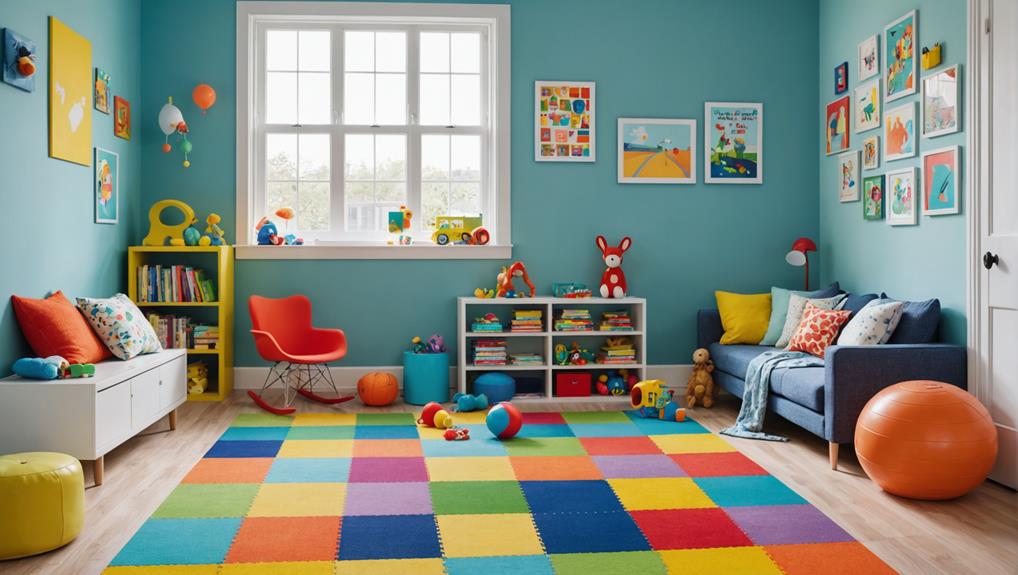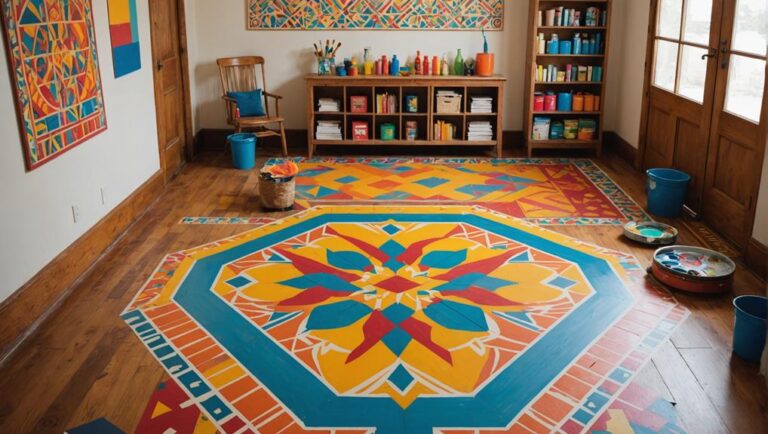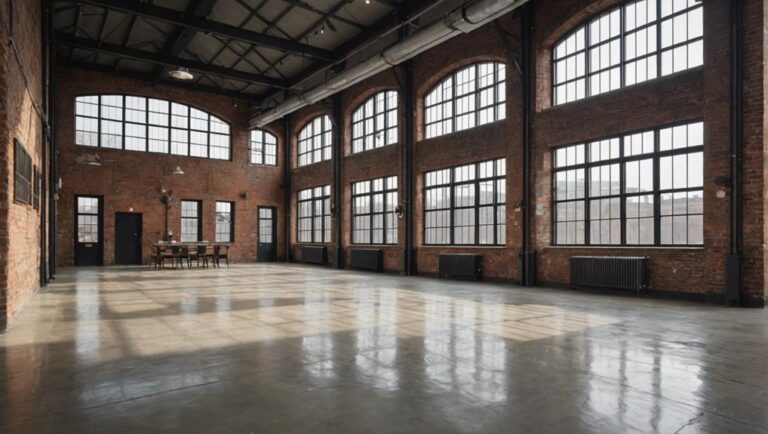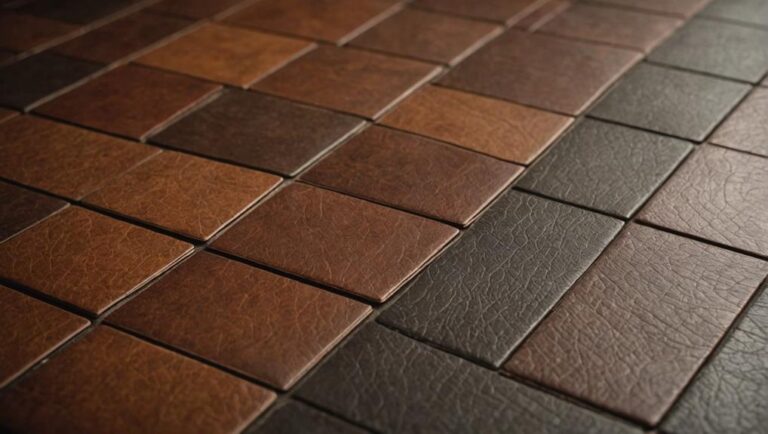When choosing shock-absorbent flooring for your kids' rooms, safety and comfort are key. This type of flooring reduces injury risks from falls and cushions playful activities. Options like rubber flooring or foam tiles offer durability and easy maintenance, perfect for busy spaces. Look for non-toxic materials and verify they're water-resistant to handle spills. Installing interlocking tiles can be a quick DIY project, fitting over existing floors. Regular cleaning will keep your flooring in good condition, so you can relax while your kids explore. There are more important considerations to keep in mind as you decide on the best choice for your home.
Benefits of Shock-Absorbent Flooring
When it comes to creating a safe and comfortable environment for your kids, shock-absorbent flooring offers several key benefits that you shouldn't overlook. One of the most significant safety advantages is the reduction in injury risk. Kids are naturally active and can easily trip or fall while playing. Shock-absorbent materials help cushion their falls, reducing the impact and minimizing the chance of serious injuries.
Another important benefit is noise reduction. Kids can be noisy, and their playful activities often result in clattering toys and running feet. Shock-absorbent flooring helps dampen sound, creating a quieter atmosphere. This can be particularly beneficial if your child's room is close to other living spaces or if you have younger siblings who need naps. A quieter environment not only promotes better sleep but also encourages focused playtime and study habits as they grow older.
Additionally, shock-absorbent flooring is often easier to clean and maintain compared to traditional flooring options. Spills and messes are inevitable with kids, and having a floor that's easy to wipe down can save you time and stress.
Investing in shock-absorbent flooring means you're prioritizing your children's safety and comfort. It's a simple yet effective way to create a nurturing space where they can play, explore, and grow without the constant worry of injury or excessive noise. So, when you consider your options, don't underestimate the value of shock-absorbent flooring in your kids' rooms.
Types of Shock-Absorbent Materials
Exploring the various types of shock-absorbent materials can help you make an informed decision for your child's room. When it comes to guaranteeing a safe play environment, two popular options are rubber flooring and foam tiles. Each offers unique benefits, making them worthy of consideration.
Rubber flooring is a durable choice that can withstand heavy use and is often used in gyms and playgrounds. It's designed to absorb impact, reducing the risk of injury from falls. Rubber flooring comes in various thicknesses and can be installed as rolls or tiles, allowing for flexibility in design. Plus, it's easy to clean, making it a practical option for busy households.
On the other hand, foam tiles provide a softer surface that's both cushioned and colorful, appealing to young children. These interlocking tiles are lightweight and portable, which means you can rearrange or remove them as needed. Foam tiles are also water-resistant, making them suitable for areas prone to spills. However, while foam tiles are great for reducing impact, they may not be as long-lasting as rubber flooring in high-traffic areas.
When choosing between rubber flooring and foam tiles, consider the specific needs of your child's room, including the level of activity and potential for spills. Safety should always be your top priority, so whichever option you choose, confirm it meets the safety standards necessary for your child's well-being.
Key Features to Consider
Choosing the right shock-absorbent flooring for your child's room involves more than just picking a material. You need to guarantee that it meets essential safety standards while also aligning with your home's design aesthetics. Here are four key features to take into account when making your decision:
- Impact Resistance: Look for flooring that can effectively absorb shock from falls. Materials like rubber or foam can greatly reduce injury risk, making them ideal for active play areas.
- Non-Toxic Materials: Confirm the flooring is made from non-toxic substances. Many manufacturers offer products that are free from harmful chemicals, which is vital for your child's health.
- Ease of Maintenance: Kids can be messy! Choose flooring that's easy to clean and maintain. Water-resistant options are particularly beneficial, as they can handle spills and accidents without damage.
- Comfort and Cushioning: The right flooring should provide a comfortable surface for play. Look for options that offer a good amount of cushioning, allowing your child to play safely and comfortably.
When selecting flooring, remember that it needs to balance safety and design aesthetics. You don't have to sacrifice style for safety; many modern options come in various colors and patterns that can seamlessly blend into your child's room decor. Prioritize these features to create a safe, functional, and visually appealing environment for your little one.
Installation Options and Tips
Installing shock-absorbent flooring in your child's room can be a straightforward process, but it requires careful planning and execution. First, you should assess the room's layout and determine the most suitable flooring type. Options like foam tiles, rubber flooring, and carpet can be excellent choices, each offering unique benefits regarding safety and comfort.
When considering installation techniques, think about whether you want a DIY approach or if you'll hire a professional. If you opt for DIY, make sure you have the right tools and follow the manufacturer's guidelines closely. For example, interlocking foam tiles are typically easy to install and can be laid directly over existing flooring, making them a popular choice for quick setups.
Before you start, measure the room accurately to determine how many tiles or rolls of flooring you'll need. Also, consider the flooring layouts—whether you want a uniform pattern or something creative. Remember, a well-planned layout not only looks good but can also enhance safety by minimizing seams where tripping may occur.
As you install, pay attention to the subfloor condition. It should be clean and dry to guarantee proper adhesion and longevity of the flooring. If you encounter any uneven areas, it's best to level them out before laying the new flooring. Finally, allow sufficient time for any adhesives to cure before letting your child play on the new surface, guaranteeing a safe and durable environment for their activities.
Maintenance and Care Guidelines
Once you've successfully installed shock-absorbent flooring in your child's room, maintaining it is key to ensuring its longevity and safety. With the right care, you can keep the flooring in excellent condition while providing a safe environment for your kids. Here are some important maintenance and care guidelines to follow:
- Regular Cleaning: Use a vacuum or a soft broom to remove dust and debris. This prevents dirt from scratching the surface and keeps the area tidy.
- Spot Cleaning: For spills or stains, use a damp cloth with a gentle cleaning solution. Avoid harsh chemicals, as they can damage the flooring material. Always test a small area first.
- Moisture Control: Make sure to dry any wet areas promptly. Excess moisture can lead to mold growth and compromise the flooring's shock-absorbent properties.
- Safety Precautions: Periodically check for any loose edges or wear. Address any damage immediately to prevent tripping hazards.
Frequently Asked Questions
Can Shock-Absorbent Flooring Reduce Noise in Kids' Rooms?
You might've heard that certain flooring can help with noise levels. It's true that shock-absorbent flooring can greatly impact sound absorption and impact reduction. By using materials designed to dampen sound, you can create a quieter environment, which is especially beneficial for kids. Just remember, while it helps reduce noise, it's important to make sure the flooring is also safe and non-toxic, providing a secure space for your little ones to play and explore.
Is Shock-Absorbent Flooring Safe for Infants and Toddlers?
When considering if shock-absorbent flooring is safe for infants and toddlers, you should prioritize impact resistance and material safety. These floors are designed to cushion falls, minimizing injury risk. However, verify the materials used are non-toxic and free from harmful chemicals. Always check for safety certifications to guarantee your child's environment is secure. Taking these precautions can help create a safer space for your little ones to explore and play.
What Is the Average Lifespan of Shock-Absorbent Flooring?
The average lifespan of shock-absorbent flooring can range from 10 to 30 years, depending on the material and maintenance requirements. It's essential to regularly clean and inspect the flooring to guarantee its durability and safety over time. If you notice signs of wear, consider replacing it sooner to maintain a safe environment. Always choose high-quality options and follow manufacturer guidelines to maximize lifespan and minimize any potential hazards for your space.
Are Eco-Friendly Options Available for Shock-Absorbent Flooring?
Imagine a forest, lush and vibrant, where every step you take feels gentle and kind. Eco-friendly options for flooring do exist, boasting sustainability features that are as comforting as a warm embrace. When you're considering installation processes, make certain they're safe and non-toxic. Always check for certifications to guarantee your choice not only protects your loved ones but also the planet. With these options, you can create a safe haven that's both responsible and nurturing.
How Does Shock-Absorbent Flooring Compare to Traditional Flooring in Cost?
When it comes to cost, shock-absorbent flooring typically has a higher initial price than traditional options. You'll also want to take into account the installation process, which can be more complex and may require professional help, increasing costs further. However, maintenance requirements for shock-absorbent flooring are often lower, as it can be easier to clean and more durable. Ultimately, investing in safety might outweigh the initial expense, providing peace of mind for you and your family.




